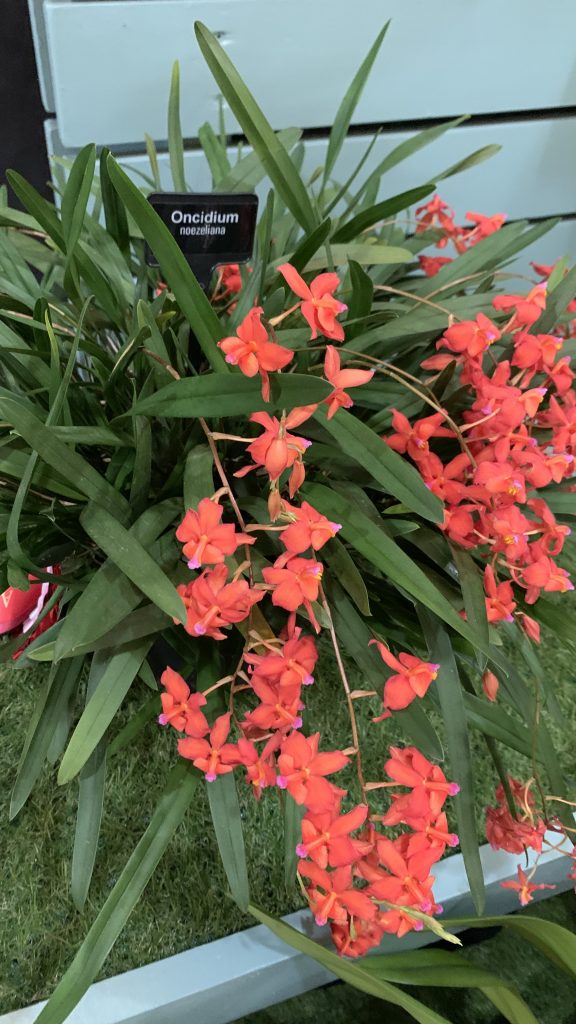Sheffield & District Orchid Society

The Warm growing Oncidiums and allied genera
There are several hundred recognised oncidium species, plus a large number of hybrids. The most common oncidiums grow well under normal indoor conditions as well as intermediate to warm greenhouse conditions. They have large pseudobulbs that arise from a mass of thin white roots. The large leaves (up to 2 ft.) emerge from the pseubobulbs. Most species generally flower in autumn although modern hybrids flower all year round.
Light: Oncidiums are much more forgiving of bright, even direct, light than other popular orchids, they can handle direct morning light and prefer bright to very bright conditions. The leaves should be bright green as opposed to dark green or reddish green. Reddish green indicates too much light and dark green too little light. Water: During the growing season, water every few days, they should however be moderately dry between watering. Be careful, though, drainage is an absolute priority, and the potting media must be perfectly free draining. Since oncidiums have large, fleshy pseubobulbs and masses of roots, they are very prone to rot. If you see a psuedobulb beginning to rot, cut it out with sterile secateurs and reduce the amount of water. In the winter, reduce watering to monthly or less. They can withstand considerable drought because of their large pseudobulbs. Wrinkled pseudobulbs generally indicate a lack of water.
Fertiliser: During the growing season, feed with a weak orchid fertiliser every 2nd or 3rd watering. Although there are many species and hybrids, in general, the larger the plant, the more heavily it will feed.
Temperature: Warm growing oncidiums can be found in many habitats, from semiarid subtropical lowlands to high mountain region cloud forests. Generally, the most popular oncidiums, which feature small yellow flowers, large pseudobulbs and strappy leaves, are intermediate to warm orchids with minimum temperatures ranging from 13°C, to 25°C.
Humidity: Oncidiums enjoy moist air, requiring a minimum of 40-50% humidity in the immediate vicinity of the plant. Humidity should be increased with higher temperatures. The ideal humidity is between 55 and 75%, with as much ventilation or air movement as possible without any cold drafts.
Flowering: Oncidiums are magnificent in flower. A large, well grown plant may send out six or seven branched sprays of yellow flowers. The effect is very much like a cloud of butterflies each flower resembling dancing ladies.
Potting: Oncidiums do not like root disturbance and should only be repotted when either the compost becomes broken down or the pot becomes too small for the new growth. They like to be slightly under potted in a very free draining bark based potting media. In general only repot when necessary but every two years is ideal when the new growth is 2-3 inches long.
The Cool growing Oncidiums and allied genera
These are mainly the former Odontoglossum group, often labelled as Cambria type hybrids, and are widely available and relatively easy to grow.
Species Oncidium are more challenging and suitable for enthusiasts only.
Light: Oncidiums (cool growing types) grow under filtered subdued light ; in the home they do best in a North or North-East facing window. However, do not place them in the middle of the room as they need to be close to a certain amount of light to do well. In the greenhouse, they need shade from late March until the end of September. We do not recommend putting Oncidiums outside during summer due to the risk of wind and sun damage to the leaves.
Fertiliser: Most hybrids grow continuously all the year round and so feeding should match. From February until August, feed with high nitrogen (20:10:10), using it at half strength at every second watering. From September until February, feed with high potash (4:4:8), using it at half strength at every second watering. Occasionally a foliar feed can be used as a tonic.
Watering and Humidity : Water every 5-7 days, all the year round if they are being grown as house plants. In the greenhouse, water every 4-7 days from the end of February until September, depending on weather conditions. During October and November when not much heat is needed and light is reduced, they may go 10- 14 days between watering. From December until the end of February when heating is on, you will need to water every 7-10 days. The ideal humidity is between 60%-70%, but do not worry if this falls in summer while the ventilators are open. This can be remedied by floor damping in the early evening.
Temperature: Cool growing Oncidium, mainly from the high Andes need a minimum night temperature of 52°F (11°C). This should rise in the daytime by 10°F (6°C) during Autumn and Winter and by 20°F (11°C) during Spring and Summer. Temperatures a little outside these extremes can be tolerated.
Ventilation should be used from March to September. Oncidiums love fresh, airy conditions and it is a good idea to install a circulating fan, running all the time.
Flowering: Most Oncidiums flower once each year when mature, the blooms lasting six weeks or more. The main flowering time used to be late winter and spring, but modern breeding has given us plants in flower at any time of the year.
Potting: Repotting is best carried out from February to April or late August to early October. The timing depends on the young shoot being between 1 inch and 3inches in height.
Reproduced by kind permission of John Gay